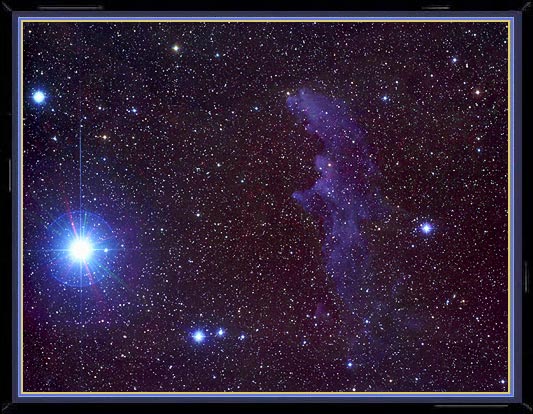







| BOOKS | F. A. Q. | ARTICLES | TALKS | ABOUT KEN | DONATE | BEYOND OUR KEN |
|---|
By Ken Croswell
Published in Sky and Telescope (April 2007, page 26)

Image by Bill and Sally Fletcher. Used by permission.
A painting owes its color to its artist, but the colors of interstellar nebulae arise from the stars that illuminate them. Although many such clouds are red, the obscure Witch Head Nebula in Eridanus shines an eerie blue. German astronomer Max Wolf discovered it a century ago, saying it "has the appearance of foggy clouds driven by a fresh breeze." American astronomer Frank E. Ross later named it "the Witch's Head Nebula."
In 1922, Edwin Hubble--who today is better known for his extragalactic work--reported that he'd identified the Witch Head's illuminator: the blue supergiant Rigel, brightest star in Orion, just 2.5 degrees to the east-southeast. He noted that the nebula looks like an arc with Rigel at its center.

Rigel is no ordinary star. Of the 10 million stars within 1,000 light-years of Earth, Rigel ranks number one, radiating more light than any other. Each minute it casts off more light than the Sun generates in a month. At its distance of roughly 800 light-years, Rigel is the seventh brightest star in the night. If it were in Alpha Centauri's place, it'd look nearly as bright as the full Moon.
Yet for all its luster, Rigel is too cool to turn the Witch Head red. As Hubble discovered, red nebulae owe their color, oddly enough, to the bluest illuminators--stars of spectral types O and B0. These stars are so hot they emit extreme ultraviolet radiation, which tears electrons from hydrogen and other gases. When these electrons rejoin protons or nitrogen ions, they can emit red light.
Rigel's B8 spectral type means the star is too cool to ionize hydrogen. Instead, dust grains peppering the Witch Head scatter some of Rigel's light toward us. Since Rigel is blue, so is the nebula. Hubble compared the Witch Head with the blue nebulosity in the Pleiades cluster, whose stars are also too cool to color gas red.
Rigel hasn't long to live. Within 2 million years it will explode as a supernova, making the Witch Head glisten more brightly than ever. Then, as the supernova fades, the nebula will turn dark.
Nevertheless, small sections will continue to shine, because T Tauri stars--precursors of stars like the Sun--have formed from the Witch Head's gas. Maria Kun (Konkoly Observatory, Hungary) and her colleagues believe winds from Orion's many O and B stars have compressed the gas, triggering starbirth. These more modest suns may someday perform an even greater feat than Rigel: illuminating planets like our own.
Ken Croswell is an astronomer in Berkeley, California. His latest book is Ten Worlds. A large color photograph of the Witch Head Nebula appears on page 68 of his book Magnificent Universe.
"On the basis of its striking design and photographs, this handsome, large-format volume is well worthy of praise. And astronomer Croswell's concise yet conversational, information-packed text wins it sky-high accolades in the narrative sphere as well."--Publishers Weekly, starred review. See all reviews of Ten Worlds here.
"Magnificent Universe by Ken Croswell is elegant and eloquent."--Washington Post. See all reviews of Magnificent Universe here.
Kun, Maria, Aoyama, Hiroko, Yoshikawa, Nao, Kawamura, Akiko, Yonekura, Yoshinori, Onishi, Toshikazu, and Fukui, Yasuo, 2001. Study of Molecular Clouds and Star Formation in the Region of IC 2118. Publications of the Astronomical Society of Japan, 53, 1063.
Kun, M.., and Nikolic, S., 2003. Low-Mass Star Formation Induced by the Orion-Eridanus Bubble. In The Interaction of Stars with Their Environment II. Edited by Cs. Kiss, M. Kun, and V. K�nyves (Budapest, Hungary: Konkoly Observatory of the Hungarian Academy of Sciences), page 19.
Kun, M., Prusti, T., Nikolic, S., Johansson, L. E. B., and Walton, N. A., 2004. The IC 2118 Association: New T Tauri Stars in High-Latitude Molecular Clouds. Astronomy and Astrophysics, 418, 89.
Morgan, W. W., Str�mgren, Bengt, and Johnson, Hugh M., 1955. A Description of Certain Galactic Nebulosities. Astrophysical Journal, 121, 611.
Nakano, Makoto, Wiramihardja, Suhardja D., and Kogure, Tomokazu, 1995. Survey Observations of Emission-Line Stars in the Orion Region. V. The Outer Regions. Publications of the Astronomical Society of Japan, 47, 889.
Ross, Frank E., 1927. Photograph of the Orion Nebulosities. Astrophysical Journal, 65, 137.
Rozhkovsky, D. A., 1981. On the Luminosity Sources of Reflection Nebula IC2118. Astronomicheskii Tsirkulyar No. 1149.
Spuck, T. S., Bowser, D. H., II, Ehrhart, B. R., Maranto, A. R., Greer, M. T., Preis, J. V., Weston, P. D., Rebull, L. M., Roelofsen, T. E., Sepulveda, B., Hughes, A. S., Sharma, N. D., Weehler, C. R., and Herrera, J. M., 2005. Spitzer Observations of Young Stars in the Witch Head Nebula (IC2118). Bulletin of the American Astronomical Society, 37, 1476.
Weehler, C. R., Herrera, J. M., Maranto, A. R., Greer, M. T., Preis, J. V., Weston, P. D., Rebull, L. M., Roelofsen, T. E., Sepulveda, B., Hughes, A. S., Sharma, N. D., Spuck, T. S., Bowser, D. H., II, and Ehrhart, B. R., 2005. Spitzer Space Telescope Research Program for Teachers and Students: Young Stars in IC2118. Bulletin of the American Astronomical Society, 37, 1337.
Wolf, Max, 1905. The Great Nebula of Psi Eridani. Monthly Notices of the Royal Astronomical Society, 65, 528.
| BOOKS | F. A. Q. | ARTICLES | TALKS | ABOUT KEN | DONATE | BEYOND OUR KEN |
|---|